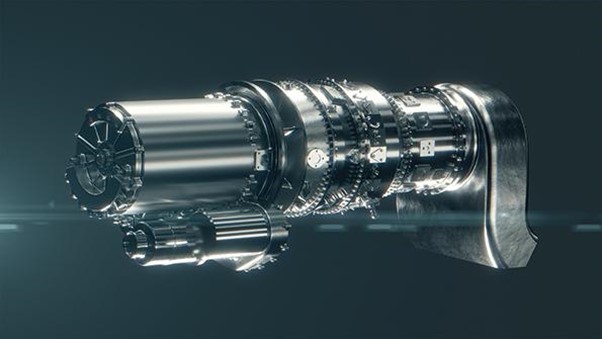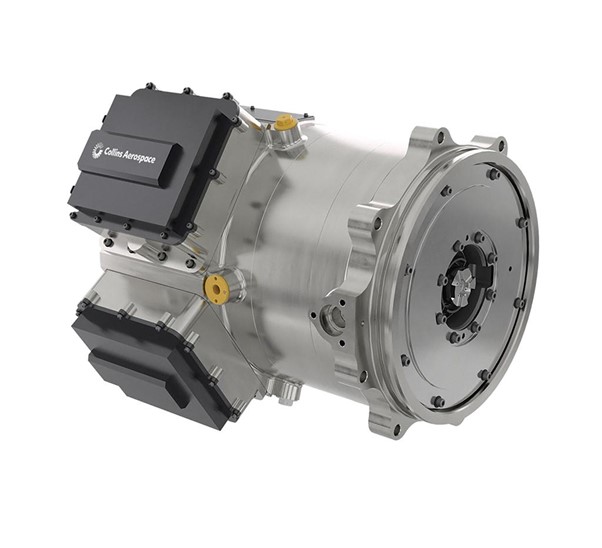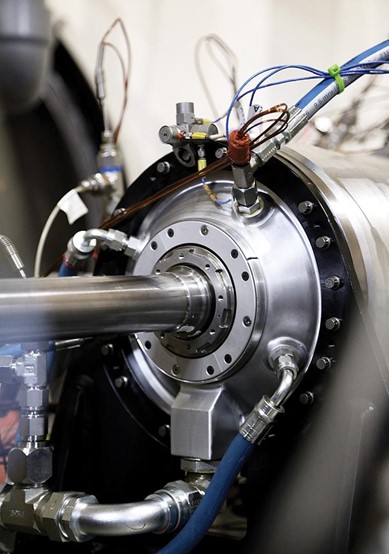
Visit
Register
New turbogenerators emerge for hybrid-electric power sector
New turbogenerators emerge for hybrid-electric power sector
SKY OF THE FUTURE | 23 AUGUST 2022

Rolls-Royce | Rolls-Royce’s new 780-kW turbogenerator is expected to start tests in Dahlewitz, Germany, by the end of the year.
Traditional engine-makers appear to be closing in on the sweet spot between conventional powerplants and batteries as the development of hybrid-electric propulsion systems for advanced air mobility as well as small and medium transport aircraft accelerates.
Joining early pioneers Honeywell and Safran in this emerging hybrid space, General Electric, Pratt & Whitney and Rolls-Royce are all actively developing systems that among them cover the waterfront from electric short- and vertical-takeoff-and-landing (eSTOL/eVTOL) aircraft to regionals and single-aisle applications.
Under the auspices of parent Raytheon Technologies, Collins Aerospace and Pratt are stepping up advanced research and testing in the sector by developing a hybrid-electric technology demonstrator program dubbed STEP-Tech (scalable turboelectric powertrain technology). Currently under construction at the Raytheon Technologies Research Center (RTRC) in East Hartford, Connecticut, the facility will begin ground tests later this year.
Focused on high-voltage distributed turboelectric hybrid-electric propulsion concepts in the 100-500-kW class, with potential to grow to 1 megawatt and beyond, the demonstrator is modular and scalable to enable rapid prototyping for a range of configurations.
“In this space, you’ll have a series and a distributed hydroelectric propulsion system,” says Frank Preli, vice president of propulsion and materials technologies for Pratt & Whitney. “We’ll have a turbogenerator generating electricity, and that will be managed across one or more propulsors.
“So in certain applications, you may have a dozen of these, and this facility gives us the ability to look at each aspect of that system and optimize each one individually or as a system,” he adds. “Having it over at RTRC also gives us the ability to move very quickly.”
The turbogenerator in the STEP-Tech demonstrator will be based on a version of the thermal engine under development by Pratt & Whitney Canada for the De Havilland Canada Dash 8-100-based hybrid-electric propulsion flight demonstrator. The C$163 million ($124 million) project, which includes De Havilland, is due to start flight tests beginning in 2024. The demonstrator—a successor to Project 804, an earlier hybrid demonstrator plan that was subsequently sidelined—targets a 30% reduction in fuel burn and CO2 emissions on a 250-mi. sector, compared with a current state-of-the-art regional.
Meanwhile, Collins has completed the critical design review for the Dash 8-100’s 1-megawatt electric motor and controller unit, both of which have been successfully run at full current, voltage and speed, clearing the way for ground tests in Canada this year. The RTRC demonstrator will also include energy storage, power electronics and modular electrically driven propulsors, adding to a growing suite of extensive test facilities and electric-propulsion-related development work across the company. In addition to the converted Dash 8-100 testbed, Collins continues to develop the Grid—a $50 million aircraft electrification and electric propulsion laboratory in Rockford, Illinois. Initially expected to have started tests in 2021, the 25,000 ft.2 lab is now set to begin operations in 2023 following delays and revisions to some programs, including a focus on the rebaselined hybrid-power successor to Project 804. “[The Grid] was slowed down” to align with user demand, says Bill Dolan, vice president of engineering and technology for power and controls at Collins. “We wanted to get an airframer, and we have that with De Havilland. So essentially the Grid is on pace for what we think that demand is. We’re [also] testing right now at the University of Nottingham, UK, and that was also a part of the plan as we slowed a little bit on the Grid to make sure that, you know, we were headed down the right path.” |  Collins Aerospace | Collins is preparing for key integrated ground tests of its newly developed 1-megawatt motor, following completion of a critical design review. Collins Aerospace | Collins is preparing for key integrated ground tests of its newly developed 1-megawatt motor, following completion of a critical design review. |
Incorporating lessons learned from the Airplane Power Systems Integration Facility (APSIF)—where the Boeing 787’s 1.5-megawatt electric system was tested—and from the Common Automated System Integration Lab, which tested systems for the Airbus A220 and Comac C919, the Grid is designed for an initial capability of 8 megawatts with expansion to 13 megawatts. The facility will be used shortly to test the Dash 8 demonstrator motor and motor controller, both of which were developed at the Collins Solihull, England, site before initial testing at the University of Nottingham’s Institute for Aerospace Technology.
By late June, Collins had tested the motor drive system up to 400 kW. “So we’re almost halfway there,” Dolan says. “We are going to continue testing to make sure the machines are working just as we planned. We’re sort of stretching the limits right now on the test, and so we’re working with the university to improve that, and we’ll continue that testing later this year. Our plan includes integrating this with the engine at Pratt & Whitney and doing integrated engine testing.”
The motor will have four times the power density of “our prior best in class,” Dolan says. “As we look at the motor controller, this is going to be upward of 10 times the power density as our current motor controller on the 787.”
Further off, Pratt and Collins say the motor and motor controller for the regional demonstrator “is allowing us to greatly expand our expertise and capability around component design, power management and system integration, which will support eventual demonstrators at single--aisle scale.” In this role, at least initially, the turbogenerator will provide a lower level of electrical hybridization of the gas turbine to boost takeoff and climb power as well as enable improved overall engine control and reoptimization of the cycle.
The integrated design—as applied to a derivative of Pratt & Whitney’s PW1100G geared turbofan—would be “slightly different” from the system in development for the Dash 8 demonstrator, Dolan says. “It would be most likely [integrated] on the low spool, and I’m sure it would need to be adapted slightly for a single-aisle application,” he adds. “So it would not be the same motor for sure.”
Further evolution and technology advancement will be required for an Airbus A320-type mission. “I’m not sure we’re going to have a product in the next two years that we’re going to say: ‘Oh, yeah, there’s our megawatt motor,’ Dolan says. “We need to continue to evolve that and make it more efficient and power dense.”
GE Aviation is similarly developing hybrid-electric propulsion technology that will be applicable to smaller aircraft and, eventually, single-aisle airliners. As a part of NASA’s Electrified Powertrain Flight Demonstration (EPFD) project, for which GE was awarded a $179 million contract in September 2021, the company is in the initial stages of developing a megawatt-scale hybrid-electric propulsion system that will be flight-tested on a Saab 340B testbed powered by modified CT7-9B turboprops.
As part of the EPFD, GE recently completed what it says is the world’s first test in simulated altitude conditions of a megawatt-class and multikilovolt hybrid-electric propulsion system. Conducted in NASA’s Electric Aircraft Testbed facility in Sandusky, Ohio, Arjan Hegeman, general manager of Advanced Technologies for GE Aviation, says: “The tests truly demonstrated the maturity of the technology to operate as an integrated system at flight altitudes up to 45,000 ft. So it’s a massive milestone on our journey toward having electrified flight in commercial use.”
Tests of the high-power, high-voltage system included two sets of electric motors-generators, power converters, power transmission and power control systems, which successfully demonstrated performance and operation of the components in a replicated flight environment. The trials “proved that it can work reliably at altitude,” Hegeman says.
Operational modes evaluated in the facility included power transfer from side to side, power assist to a simulated engine and aircraft power generation. The implementation of energy storage was also simulated. “The energy flows in different directions,” Hegeman says. “You can use it to run the motor for the electric assist, or you can drive the motor to generate that electricity to flow it into the battery. So it’s back and forth, and there are transients there as well. So all those situations have been tested.”
Not only did the tests help validate the hybrid-electric propulsion system architecture, but they also are a key step in GE Aviation’s technology programs with NASA to develop a hybrid-electric propulsion system for flight tests later this decade and for service entry in the mid-2030s. The company is looking to develop commercial hybrid-electric turboprops for future regional transports as well as apply the technology toward mildly hybridized turbofans as part of the ongoing CFM RISE (Revolutionary Innovation for Sustainable Engines) open-fan engine program. "This is a world first, not just from a megawatt-class electric propulsion system perspective but also from the kilovolt piece,” Hegeman says. Megawatts measure electrical power, while kilovolts measure the difference in electrical potential between two points. Although a kilovolt-class system enables high efficiency and specific power, they are more difficult to manage at altitude because of several factors, including lower insulation levels in the reduced density of the upper atmosphere. “Running high power levels of energy over larger distances, say through a wing into a fuselage or to a battery, you want that to be as efficient as possible—and that’s where the kilovolt really comes into play,” Hegeman adds. “The beauty of it is once you get that working and figure out how to get it working at altitude, it’s very easy to downscale. You see a lot of news around flight tests that are being performed and systems that are operating. All of them are low voltage and low power. What we’re doing is very, very different, and that really sets us up to implement this system [for future single-aisle aircraft].” EPFD testing has now switched to safety-related evaluation of the components and the integrated system in areas such as electromagnetic interference and vibration testing. This work is being conducted at GE’s EPISCenter (Electrical Power Integrated Systems Center) in Dayton, Ohio, and will focus more on tolerance to shocks, humidity levels throughout the flight environment and other extreme conditions. |  GE | GE Aviation achieved a world first with recent simulated altitude tests of its megawatt-class hybrid-electric system in NASA’s Electric Aircraft Testbed in Ohio. GE | GE Aviation achieved a world first with recent simulated altitude tests of its megawatt-class hybrid-electric system in NASA’s Electric Aircraft Testbed in Ohio. |
“We’ll then do ground testing, where the actual CT7, the electric motor and the power electronics are sitting in the same nacelle on a test stand at Peebles,” Hegeman says, referring to the company’s outdoor test facility in Ohio. “Then it goes on the aircraft.”
For this phase, GE has partnered with Boeing and its subsidiary Aurora Flight Sciences, which is providing the aircraft, modification work, aircraft integration and flight testing. This work includes nacelle manufacturing, flight deck interface design and software, aircraft-level performance analysis and systems integration. BAE Systems will provide energy management components, including the battery and cabling. Flight tests are expected to begin in the mid-2020s.
As part of its rapidly expanding electric-propulsion portfolio, Rolls-Royce is also developing an all-new turbogenerator for use in advanced air mobility applications, including primary propulsion for eSTOL aircraft and as a range extender for eVTOL vehicles. The new turbogenerator could significantly augment the performance of the P-Volt all-electric version of the eight-passenger P2012 Traveller, which Rolls is developing with Italian general aviation company Tecnam.
With two 320-kW electric motors and an 1,100-kg (2,430-lb.) battery pack replacing a pair of 275-kW piston engines, the P-Volt is expected to fly 85 nm when it enters service in the second half of this decade, increasing to 145 nm by 2030 as battery technology improves. With the addition of a turbogenerator, however, the aircraft’s range could be extended to around 300 nm, says Matheu Parr, customer business director at Rolls-Royce Electrical.
The scalable system is therefore intended to complement the company’s electric-propulsion offerings—enabling extended range on sustainable aviation fuels (SAF), and later as it comes available, through hydrogen combustion. The new, small gas turbine at the heart of the turbogenerator is under development at Rolls-Royce’s Dahlewitz facility in Germany, where it is expected to begin running by the end of the year, Parr says.
Although Rolls originally looked at using the company’s Allison-designed M250 turbine as the basis for the turbogenerator, it later revised the plan to go with a clean-sheet configuration incorporating a two-stage axial compressor and advanced materials. “When we look at the turbogenerator market at the moment, it [consists of] repurposed auxiliary power units and helicopter gas turbines,” Parr says. “Given what the market demands in terms of fuel efficiency and power density, we see a strong opportunity for a new turbogenerator. It’s very much a clean sheet, because when you have the opportunity to design a turbogenerator for the first time. How do you make that as efficiently as possible?”
Instead of Rolls’ usual focus on lower specific fuel consumption, the chief design drivers are low overall maintenance and operating costs while simultaneously achieving a high power density. “We’re demonstrating a core at 780 kW, with a target power density at that rating of around 4 kW/kg,” Parr says. “The gas turbine is about 1 m (3.3 ft.) long, plus an electrical machine of about 0.5 m on the end of that, which is turning that mechanical power into electrical power. We are demonstrating it close to 800 kW, because that gives us all the kind of technology challenges we need. And we are working with customers to understand what is the right value that you need for a product.”
Rolls says the turbogenerator system will be scaled to serve a power range between 500 kW and two megawatts. The company says this will allow it to provide power systems for aircraft on “new longer routes that our electric battery-powered aircraft can also support.” The turbogenerator is targeted for a service entry date around 2027.
“We believe the turbogenerator will be market leading when it comes through,” Parr says. “When you think about the limitations of batteries: If you have an eVTOL traveling for 100 nm, and all of a sudden you want to go 200-250 nm, then using a gas turbine as a range extender is really a valid way of doing it.
“Equally, we’re seeing in the eSTOL market where there’s a pull for a gas turbine to enable those aircraft configurations as well,” says Parr, who identifies Lockheed Martin-backed aircraft developer Electra.aero as a potential candidate. “We see a strong role for the gas turbine as an energy source, ideally burning SAF. Then the question is: ‘How do we integrate the electrical machine to all of that in a way that’s as power-dense as possible and then integrated onto an aircraft?’"
The project is focused in Dahlewitz to leverage the company’s business jet turbofan design and development engineering expertise. Unlike conventional gas turbines that incorporate design margin for a wide range of operating points, speeds and transient conditions, the turbogenerator is designed to operate constantly at the same speed and power. “We don’t have to design for the same margins, so all of a sudden packaging gets tighter and the machine becomes more power-dense,” he notes.
By: Guy Norris
This article was first published in Aviation Week & Space Technology.
Stay current with Aviation Week Network’s latest news, analysis and insights impacting the global aviation community.
Sign up for one or more of their sector-specific digests.
